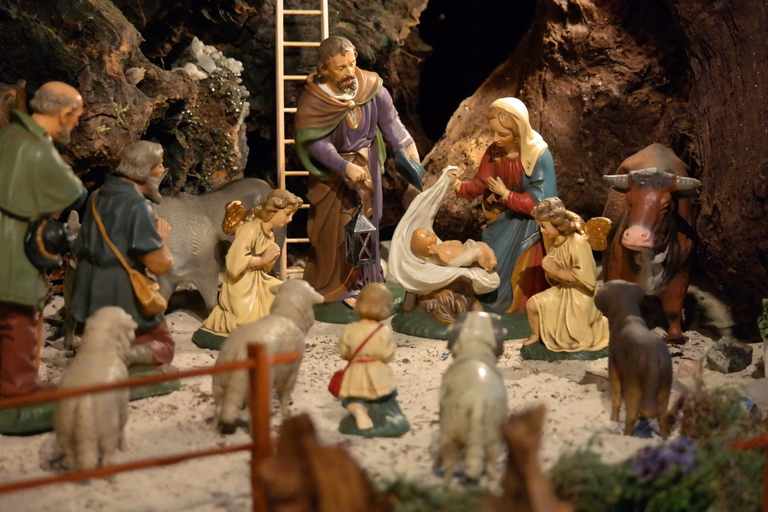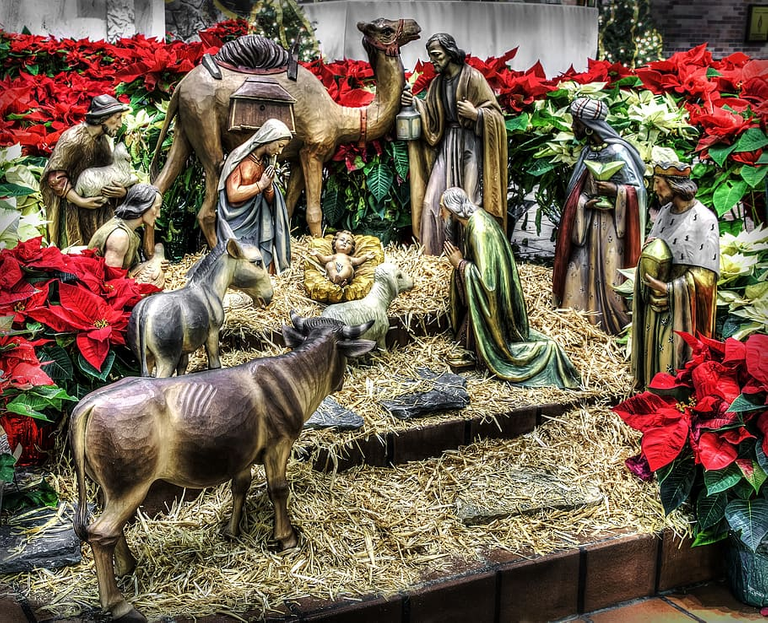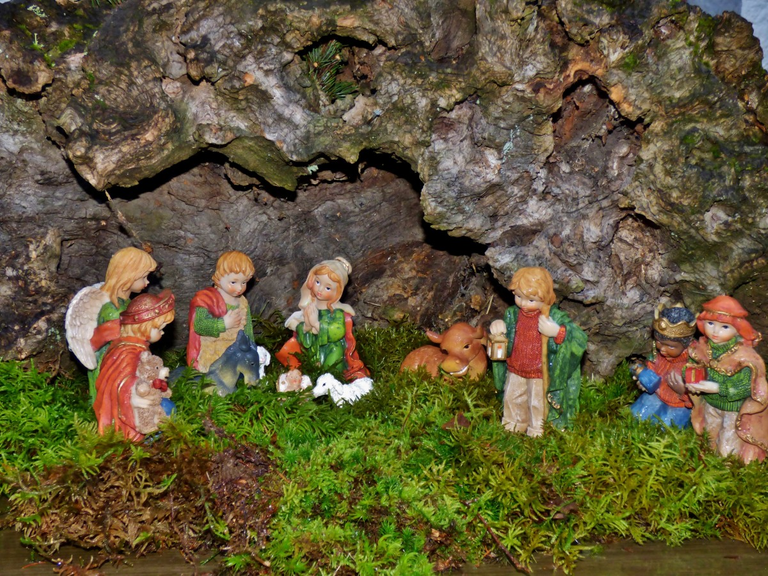

Happy day! my dear lovers of reading, a new week and I want to start it by sharing with you another chapter of the book about which I have been publishing in this community "Tales and traditions of my beloved Táriba" by the author Francisco Antonio Barrientos Ch, the chapter that I come to share today is titled:

The Nativity Scene

Before starting formally with what this author presents, it is prudent from my point of view to state that indeed, the manger, is the tradition par excellence in Venezuela to decorate before the arrival of Christmas and although in many homes still retains that tradition, In others they have opted for the Christmas tree, which is of a different origin, although a nativity scene, even a small one, is always placed somewhere in the home. There are even those who collect small nativity scenes and place them in different places in their homes to show them off to their visitors and tell them where, how and when they acquired them.

Now, as for this chapter, I was struck by the fact that the author divided it into two parts, but as I read I understood the reasons he had for doing so, as usual he begins by narrating what this tradition meant for him and for the inhabitants of his town, since for them it was a much desired activity to perform, but immediately begins to narrate about the origins of the manger or nativity and I must confess that I was surprised because I was unaware of all this, I never, but never imagined that the nativity scene was originally from the old continent, being St. Francis of Assisi the first to represent it and in a living form, from there were born another series of events that finally led to this beautiful tradition and that with its arrival to the new continent adopted new trends and forms as happened with so many other customs and beliefs to reach these lands.

In the same way, after all this rich historical content that I loved very much, the author in the second part of this chapter, and enters fully to narrate what represented the manger in Táriba and nearby areas during his childhood, the first thing that stands out is that there was a specific date for its realization, also that they were looking for boxes, wooden crates, moss, sand, aluminum foil cigar boxes and many other inputs with which you could give life to the manger, to make it unique and inimitable. As expected, each family wanted to have the best manger that year, so they met to plan and organize how they would put the manger together.

On the other hand, as usual, Francisco A. Barrientos Ch, gives us a narrative of how the first nativity scenes were and how they have evolved over time and how sadly they have become something commercial for many, this last paragraph is very emotional because you can feel the nostalgia of the author, seeing how the times and the desire to get profit for everything is introduced in all spheres.

To conclude, the nativity scene has an ancient history, it arrived to these lands by the hand of the conquerors, but it took its own style and form in this continent, being particularly popular in the Andean zones of our Venezuela, but also loved and valued, in many homes of other cities of the country, now I say goodbye, until a next publication a big hug for all and I hope to read your opinions in the comments box.



¡Feliz día! mis queridos amantes de la lectura, una nueva semana y deseo comenzarla compartiendo con ustedes otro capítulo del libro acerca del he venido realizando publicaciones en esta comunidad “Cuentos y tradiciones de mi Táriba Querida” del Autor Francisco Antonio Barrientos Ch, el capítulo que vengo a compartir hoy se titula:

El Pesebre

Antes de comenzar formalmente con lo que nos plantea este autor, es prudente desde mi punto de vista manifestar que efectivamente, el pesebre, es la tradición por excelencia en Venezuela para decorar ante la llegada de la Navidad y aunque en muchos hogares todavía se conserva esa tradición, en otros se ha optado por el árbol de navidad que es de otro origen, aunque siempre se coloca en algún lugar del hogar un pesebre así sea pequeño, incluso hay quienes coleccionan pesebres pequeños y los colocan es diversos lugares de sus hogares para presumirlos ante sus visitas y narrar dónde, cómo y cuándo los adquirieron.
Ahora bien, en cuanto a este capítulo, me llamo la atención que el autor lo dividió en dos partes, pero al ir leyendo comprendí las razones que tuvo para hacerlo, como es ya costumbre él comienza narrando lo que esta tradición significaba para él y para los habitantes de su pueblo, ya que para ellos era una actividad muy anhelada de realizar, pero de forma inmediata comienza narrar sobre los orígenes del pesebre o nacimiento y debo confesar que quede enemente sorprendía ya que ignoraba todo esto, nunca, pero nunca me imaginé que el pesebre fuera originario del viejo continente, siendo San Francisco de Asís el primero en representarlo y de forma viviente, desde allí nacieron otra serie de eventos que finalmente derivaron en esta hermosa tradición y que con su llegada al nuevo continente adopto nuevas tendencias y formas como ocurrió con tantas otras costumbres y creencias al llegar a estas tierras.
De la misma manera, luego de toda este rico contenido histórico que me encanto sobremanera, el autor en la segunda parte de este capítulo, ya entra de lleno a narrar lo que representaba el pesebre en Táriba y zonas cercanas durante su infancia, lo primero que destaca es que había una fecha en específico para su realización, además que iban buscando las cajas, guacales de madera, musgos, arenas, papel de aluminio de las cajas de cigarros y muchos otros insumos con los que se pudiera darle vida a ese pesebre, para que fuera único e inimitable. Así mismo como era de esperar cada familia deseaba tener el mejor pesebre de ese año, así que se reunían para planificar y organizar como armarían el pesebre.
Por otra parte, como es costumbre Francisco A Barrientos Ch, nos va realizando una narrativa de cómo eran los primeros pesebres y de cómo han ido evolucionando con el tiempo y de cómo tristemente se han convertido en algo comercial para muchos, este último párrafo es muy emotivo ya que se logra sentir la nostalgia del autor, al ver como los tiempos y las ansías de obtener lucro por todo se introduce en todas las esferas.

Para concluir, el pesebre tiene una historia antigua, llego a estas tierras de mano de los conquistadores, pero tomo su propio estilo y forma en este continente, siendo particularmente popular en las zonas andinas de nuestra Venezuela, pero también amado y valorado, en muchos hogares de otras ciudades del país, ahora me despido, hasta una próxima publicación un gran abrazo para todos y espero leer sus opiniones en el cajón de comentarios.



No me sorprende saber que el origen de esta tradición remonta de costumbres en el viejo continente, siempre he visto de manera muy natural como la transculturación nos hace sentir propio lo que es ajeno a nuestras raíces. Posiblemente en otras condiciones nuestras navidades serían más de ritos y adoración a los astros o fenómenos naturales, pero gracias a la invasión europea en el continente americano y siendo en Venezuela mestizos sin distinción alguna; hemos sabido adaptar a gusto propio esas viejas costumbres.
Siempre he deseado construir un enorme pesebre, más allá de lo material en mi mente visualizo tantos escenarios para la elaboración aunque lamentablemente cada año me limito a soñarlo por el coste de prácticamente todo lo que necesitaría, omitiendo porsupuesto lo que podemos encontrar en la naturaleza.
Soy de poco celebrar las festividades, pero si que adoro conectar espiritualmente con esas costumbres y sobre todo con la llegada de la navidad. Cocinar, decorar para disfrutar del juego de luces y colores de la fecha, la navidad me encanta por esos detalles que lo hacen única. Muy interesante publicación amiga Cristina, un tema sin duda para armar un buen debate y compartir ideas, pero eso ameritaría una buena taza de café y unos panesitos dulces o galletas.
!LUV !HBIT
Fíjate que yo,como mencioné desconocía esto y aunque sea originario del viejo continente estoy segura de que le danos ese toqué que lo distingue como venezolano yo también he soñado con un nacimiento grande y llenó de toda la belleza que tiene nuestra tierra, sería genial esa reunión que señalas para luego subirla a nuestros blogs
Success! You mined .9 HBIT & the user you replied to received .1 HBIT on your behalf. mine | wallet | market | tools | discord | community | <><
What's the HBITgame? | Card 2 of 4
@cesarsj5(1/1) gave you LUV. wallet | market | tools | discord | community | <><
wallet | market | tools | discord | community | <><
Hola!! Tal cual, en Argentina también se celebra la llegada de la Navidad y se decora el pesebre! Es un momento muy bello! Gracias por compartir!!
fíjate no sabía que en Argentina colocaban pesebre,bueno desconozco mucho de las costumbres y tradiciones argentinas,pero he aprendido algo gracias a tu comentario.
Este es un libro precioso. Yo soy de Táriba y este libro me pareció que refleja todo lo natural de nuestras costumbres. El pese re aunque no sea originario de nuestra tierra lo sentimos propio y ya las generaciones lo hemos adoptado. Muchas gracias por compartir tu experiencia. Saludos.
¡Que bueno que vengas por acá a comentar!, este libro me parece genial he disfrutado cada palabra de el , saber que eres de Táriba y te sientes identificada, me encanta